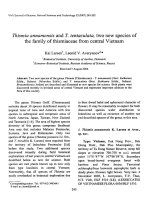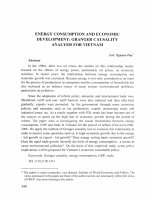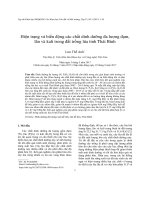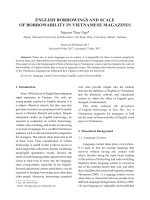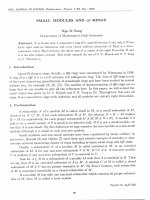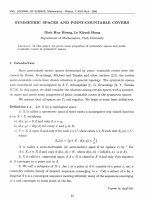AT quizzer (CPAR) evidence and documentation
Bạn đang xem bản rút gọn của tài liệu. Xem và tải ngay bản đầy đủ của tài liệu tại đây (35.39 KB, 6 trang )
Page 1 of 6
CPA REVIEW SCHOOL OF THE PHILIPPINES
Manila
AUDITING THEORY
AUDIT EVIDENCE AND DOCUMENTATION
Related PSAs: PSA 500(rev) and 230
Audit Evidence/PSA 500(rev) – Audit Evidence
1. Which statement is incorrect regarding audit evidence?
a. Audit evidence is all the information used by the auditor in arriving at the conclusions on
which the audit opinion is based.
b. Audit evidence includes the information contained in the accounting records underlying the
financial statements and other information.
c. Audit evidence is cumulative in nature.
d. Auditors are expected to address all information that may exist.
2. Accounting records least likely include
a. The records of initial entries and supporting records.
b. The general and subsidiary ledgers.
c. Work sheets and spreadsheets supporting cost allocations.
d. Comparable data about competitors (benchmarking).
3. Other information that the auditor may use as audit evidence least likely includes
a. Minutes of meetings.
b. Confirmations from third parties.
c. Information obtained by the auditor from such audit procedures as inquiry, observation, and
inspection.
d. Adjustments to the financial statements that are not reflected in formal journal entries.
4. Which statement is correct regarding the sufficiency and appropriateness of audit evidence?
a. Sufficiency is the measure of the quality of audit evidence.
b. Appropriateness is the measure of the quantity of audit evidence; that is, its relevance and
its reliability in providing support for, or detecting misstatements in, the classes of
transactions, account balances, and disclosures and related assertions.
c. The quantity of audit evidence needed is affected by the risk of misstatement (the greater
the risk, the more audit evidence is likely to be required) and also by the quality of such
audit evidence (the higher the quality, the less may be required).
d. Merely obtaining more audit evidence may compensate for its poor quality.
5. Which of the following statements is incorrect regarding relevance of audit evidence?
a. A given set of audit procedures may provide audit evidence that is relevant to certain
assertions, but not others.
b. The auditor often obtains audit evidence from different sources or of a different nature that
is relevant to the same assertion.
c. Obtaining audit evidence relating to a particular assertion is a substitute for obtaining audit
evidence regarding another assertion.
d. None of the above.
6. Which of the following generalizations in assessing the reliability of audit evidence is incorrect?
a. Audit evidence is more reliable when it is obtained from independent sources outside the
entity.
b. Audit evidence that is generated internally is not affected by the effectiveness of the
controls imposed by the entity.
c. Audit evidence obtained directly by the auditor is more reliable than audit evidence obtained
indirectly or by inference.
d. Audit evidence is more reliable when it exists in documentary form.
7. Which statement is incorrect regarding audit evidence?
a. The auditor should obtain sufficient appropriate audit evidence to be able to draw
reasonable conclusions on which to base the audit opinion.
b. Accounting records alone do not provide sufficient audit evidence.
AT-5913
Page 2 of 6
c. The auditor uses professional judgment and exercises professional skepticism in evaluating
the quantity and quality of audit evidence, and thus its sufficiency and appropriateness, to
support the audit opinion.
d. The matter of difficulty or expense involved is a valid basis for omitting an audit procedure
for which there is no alternative.
8. The auditor uses assertions in assessing risks by considering the different types of potential
misstatements that may occur, and thereby designing audit procedures that are responsive to
the assessed risks. Assertions used by the auditor fall into the following categories:
I. Assertions about classes of transactions and events for the period under audit.
II. Assertions about account balances at the period end.
III. Assertions about presentation and disclosure.
a. I, II and III
b. I and II only
c. II and III only
d. II only
9. Assertions about classes of transactions and events for the period under audit least likely
include
a. Transactions and events that have been recorded have occurred and pertain to the entity.
b. All transactions and events that should have been recorded have been recorded.
c. Transactions and events have been recorded in the correct accounting period.
d. All assets, liabilities and equity interests that should have been recorded have been
recorded.
10. Assertion about account balances at period end which means assets, liabilities, and equity
interests are included in the financial statements at appropriate amounts is
a. Existence
c. Completeness
b. Rights and obligations
d. Valuation and allocation
11. Accuracy and valuation assertions about presentation and disclosure means
a. Disclosed events, transactions, and other matters have occurred and pertain to the entity.
b. All disclosures that should have been included in the financial statements have been
included.
c. Financial information is appropriately presented and described, and disclosures are clearly
expressed.
d. Financial and other information are disclosed fairly and at appropriate amounts.
12. The auditor obtains audit evidence to draw reasonable conclusions on which to base the audit
opinion by performing audit procedures to:
a. Obtain an understanding of the entity and its environment, including its internal control, to
assess the risks of material misstatement at the financial statement and assertion levels.
b. Test the operating effectiveness of controls in preventing, or detecting and correcting,
material misstatements at the assertion level.
c. Detect material misstatements at the assertion level.
d. All of the above.
13. The auditor is not always required to perform
a. Risk assessment procedures.
b. Test of controls.
c. Substantive procedures.
d. Both a and c
14. Tests of controls are necessary
a. When the auditor’s risk assessment includes an expectation of the operating effectiveness
of controls.
b. When substantive procedures alone provide sufficient appropriate audit evidence.
c. When risk assessment procedures by themselves do not provide sufficient appropriate
audit evidence.
d. Under no circumstances.
15. Which statement is incorrect regarding Inspection as an audit procedure?
a. Inspection consists of examining records or documents or physical examination of assets.
b. Inspection of tangible assets may provide reliable audit evidence with respect to their
existence and about the entity’s rights and obligations on the assets.
c. Inspection of individual inventory items ordinarily accompanies the observation of inventory
counting.
d. Some documents represent direct audit evidence of the existence of an asset.
AT-5913
Page 3 of 6
16. Which of the following audit procedures is used extensively throughout the audit and often is
complementary to performing other audit procedures?
a. Inspection
b. Observation
c. Inquiry
d. Confirmation
17. Which statement is incorrect regarding Inquiry?
a. Responses to inquiries may provide the auditor with information not previously possessed
or with corroborative audit evidence.
b. Responses to inquiries might provide information that differs significantly from other
information that the auditor has obtained.
c. Responses to inquiries may provide a basis for the auditor to modify or perform additional
audit procedures.
d. Inquiry alone is sufficient to test the operating effectiveness of controls.
18. Observation
a. Consists of looking at a process or procedure being performed by others.
b. Consists of seeking information of knowledgeable persons, both financial and non-financial,
throughout the entity or outside the entity.
c. Is the process of obtaining a representation of information or of an existing condition directly
from a third party.
d. Is the auditor’s independent execution of procedures or controls that were originally
performed as part of the entity’s internal control.
19. This consists of checking the mathematical accuracy of documents or records.
a. Reperformance
b. Recalculation
c. Confirmation
d. Inspection
20. Which of the following is a false statement about audit objectives?
a. Audit objectives should be developed in light of management assertions about the financial
statement components.
b. Selection of tests to meet audit objectives should depend upon the understanding of
internal control.
c. The auditor should resolve any substantial doubt about any of management’s material
financial statement assertions
d. There should be a one-to-one relationship between audit objectives and procedures.
21. Which of the following is the best explanation of the difference, if any, between audit objectives
and audit procedures?
a. Audit procedures establish broad general goals, audit objectives specify the detailed work
to be performed.
b. Audit objectives are tailor-made for each assignment, audit procedures are generic in
application.
c. Audit objectives define specific desired accomplishments; audit procedures provide the
means of achieving audit objectives.
d. Audit procedures and audit objectives are essentially the same.
22. Walastik, Inc. has significant information that is transmitted, processed, maintained, and
accessed electronically. The auditor has concluded that it is not possible to reduce detection
risk to an acceptable level by performing only substantive tests for a number of financial
statement assertions. The auditor’s alternative strategy is to
a. Increase the acceptable audit risk.
b. Focus audit tests on other assertions for which substantive tests prove to be effective.
c. Require management to change its information system to provide appropriate evidence.
d. Perform tests of controls to gather evidential matter to use in assessing control risk related
to those assertions.
23. The competence of evidence available to an auditor is least likely to be affected by
a. The relevance of such evidence to the financial statement assertion being investigated.
b. The relationship of the preparer of such evidence to the entity being audited.
c. The timeliness of such audit evidence.
d. The sampling method employed by the auditor to obtain a sample of such evidence.
24. Which of the following procedures would provide the most reliable audit evidence?
a. Inquiries of the client’s internal audit staff held in private.
b. Inspection of prenumbered client purchase orders filed in the vouchers payable department.
AT-5913
Page 4 of 6
c. Analytical procedures performed by the auditor on the entity’s trial balance.
d. Inspection of bank statements obtained directly form the client’s financial institution.
25. The most reliable form of documentary evidence are those documents that are
a. Prenumbered
c. Easily duplicated
b. Internally generated
d. Authorized by a responsible official
26. Which of the following presumptions does not relate to the competence of audit evidence?
a. The more effective internal control, the more assurance it provides about the accounting
data and financial statements.
b. An auditor’s opinion, to be economically useful, is formed within a reasonable time and
based on evidence obtained at a reasonable cost.
c. Evidence obtained from independent sources outside the entity is more reliable than
evidence secured solely within the entity.
d. The independent auditor’s direct personal knowledge, obtained through observation and
inspection, is more persuasive than information obtained indirectly.
27. Assuming a low assessed level of control risk, which of the following audit procedures is least
likely to be performed?
a. Physical inspection of a sample of inventory.
b. Search for unrecorded cash receipts.
c. Obtaining of a client representation letter.
d. Confirmation of accounts receivable.
28. You have been assigned to audit the maintenance department of an organization. Which of the
following is likely to produce the least reliable audit evidence?
a. Notes on discussions with mechanics in the maintenance operation.
b. A schedule comparing actual maintenance expenses with budgeted expenses and those of
the prior period and disclosing important differences.
c. A narrative covering review of user reports on maintenance service.
d. An analysis of changes in certain maintenance department ratios.
29. Which of the following auditing procedures is ordinarily performed last?
a. Reading of the minutes of the directors’ meetings.
b. Confirming accounts payable.
c. Obtaining a management representation letter.
d. Testing of the purchasing function.
30. Before applying substantive tests to the details of asset accounts at an interim date, an auditor
should assess
a. Control risk at below the maximum level.
b. Inherent risk at the maximum level.
c. The difficulty in controlling the incremental audit risk.
d. Materiality for the accounts tested as insignificant.
31. Before applying principal substantive tests to the details of accounts at an interim date prior to
the balance sheet date, an auditor should
a. Assess control risk as below the maximum for the assertions embodied in the accounts
selected for interim testing.
b. Determine that the accounts selected for interim testing are not material to the financial
statements taken as a whole.
c. Consider whether the amounts of the year-end balances selected for interim testing are
reasonably predictable.
d. Obtain written representations from management that all financial records and related data
will be made available.
32. If an auditor conducts an audit of financial statements in accordance with generally accepted
auditing standards, which of the following will the auditor most likely detect?
a. Misposting of recorded transactions
c. Forgery
b. Unrecorded transactions
d. Collusive fraud
AT-5913
Page 5 of 6
Working Papers/PSA 230 – Documentation
1. It means the materials prepared by and for, or obtained and retained by the auditor in
connection with the performance of the audit.
a. Documentation
c. Engagement letter
b. Audit evidence
d. Audit report
2. Which of the following is not a purpose of working papers?
a. Assist in the planning and performance of the audit.
b. Assist in the supervision and review of the audit work.
c. Record the audit evidence resulting from the audit work performed to support the auditor’s
opinion.
d. Support the client’s financial statements.
3. Why does an auditor document audit evidence?
a. To comply with the requirements of gathering all available evidence.
b. To provide client reference for all account balances and correcting entries.
c. To support audit opinion and to provide evidence that the audit was carried out in
accordance with PSA.
d. To document all records of misstatements noted in the financial statements.
4. Working papers that record the procedures used by the auditor to gather evidence should be
a. Considered the primary support for the financial statements being audited.
b. Viewed as the connecting link between the books of accounts and the financial statements.
c. Designed to meet the circumstances of the particular engagement.
d. Destroyed when the audited entity ceases to be a client.
5. Which of the following conditions constitutes inappropriate working paper preparation?
a. Flowcharts are included in the working papers.
b. Findings are cross-referenced to supporting documentation.
c. Tick marks are explained in working papers.
d. All forms and directives used by the auditee department are included in the working papers.
6. An auditor’s working papers will ordinarily be least likely to include documentation showing how
the
a. Client’s schedules were prepared.
b. Engagement was planned.
c. Understanding of the client’s internal control was obtained and control risk was assessed.
d. Unusual matters were resolved.
7. Which of the following is usually included or shown in the auditor’s working papers?
a. The procedures used by the auditor to verify the personal financial status of members of the
client’s management team
b. Analyses that are designed to be a part of, or a substitute for, the client’s accounting
records
c. Excerpts from authoritative pronouncements that support the underlying generally accepted
accounting principles used in preparing the financial statements
d. The manner in which exceptions and unusual matters disclosed by the auditor’s procedures
were resolved or treated
8. The form and content of working papers are affected by matters such as the:
I. Nature of the engagement.
II. Form of the auditor’s report.
III. Nature and complexity of the business.
IV. Nature and condition of the entity’s accounting and internal control systems.
V. Needs in the particular circumstances for direction, supervision and review of work
performed by assistants.
VI. Specific audit methodology and technology used in the course of the audit.
a. All of the above
c. I, II and III only
b. All except V and VI
d. All except VI
9. Which of the following is not generally included in the working papers file?
a. An indication as to who performed the audit procedures and when they were performed.
b. Documentation of the auditor’s understanding of the accounting and internal control
systems.
c. Copy of the internal audit’s audit program.
d. Analyses of significant ratios and trends.
AT-5913
Page 6 of 6
10. Although the quantity and content of audit working papers vary with each particular
engagement, an auditor’s permanent files most likely include
a. Schedules that support the current year’s adjusting entries.
b. Prior years’ accounts receivable confirmations that were classified as exceptions.
c. Documentation indicating that the audit work was adequately planned and supervised.
d. Analyses of capital stock and other owners’ equity accounts.
11. Audit working papers are indexed by means of reference numbers. The primary purpose of
indexing is to
a. Permit cross-referencing and simplify supervisory review.
b. Support the audit report.
c. Eliminate the need for follow-up reviews.
d. Determine that working papers adequately support findings, conclusions, and reports.
12. The audit working paper that reflects the major components of an amount reported in the
financial statements is the
a. Interbank transfer schedule
c. Supporting schedule
b. Carryforward schedule
d. Lead schedule
13. An auditor ordinarily uses a working trial balance resembling the financial statements without
footnotes, but containing columns for
a. Cash flow increases and decreases
c. Reclassifications and adjustments
b. Audit objectives and assertions
d. Reconciliations and tickmarks
14. In the course of the audit of financial statements for the purpose of expressing an opinion
thereon, the auditor will normally prepare a schedule of unadjusted differences for which he did
not propose adjustment when they were uncovered. The primary purpose served by this
schedule is to
a. Point out to the responsible client officials the errors made by various company personnel.
b. Summarize the adjustments that must be made before the company can prepare and
submit its income tax returns.
c. Identify the potential financial statement effects of errors or disputed items that were
considered immaterial when discovered.
d. Summarize the errors made by the company so that corrections can be made after the
audited financial statements are released.
15. Which of the following analyses appearing in a predecessor’s working papers is the successor
auditor least likely to be interested in reviewing?
a. Analysis of noncurrent balance sheet accounts. c. Analysis of income statement accounts.
b. Analysis of current balance sheet accounts.
d. Analysis of contingencies.
16. In an internal audit, the audit supervisor determines that working papers are complete
a. When satisfied that the audit objectives have been met and the working papers support the
conclusions.
b. When working papers refer to the steps outlined in the audit program.
c. Only after the auditor who prepared the working papers has signed and dated them.
d. When proper cross-references to other working papers are noted.
17. Standardized working papers are often used, chiefly because they allow working papers to be
prepared more
a. Efficiently
b. Professionally
c. Neatly
d. Accurately
18. Ordinarily, the audit may use schedules, analyses and other documentation prepared by entity
personnel in order to:
a. Lessen auditor’s responsibility.
b. Eliminate the need to apply any audit procedures on verifying their correctness.
c. Emphasize that the responsibility on financial statements rests with the client management.
d. Improve audit efficiency.
19. Working papers which contain information relating primarily to the audit of a single period.
a. Current audit files
c. Financial reporting files
b. Permanent audit files
d. Correspondence files
20. Which of the following is the least required of the audit working papers?
a. Substitute for the entity’s accounting records.
b. Confidentiality of information included in the working papers.
c. Safe custody of the working papers.
d. Retention for a period sufficient to meet the needs of the practice.
- end of AT-5913 -
AT-5913

